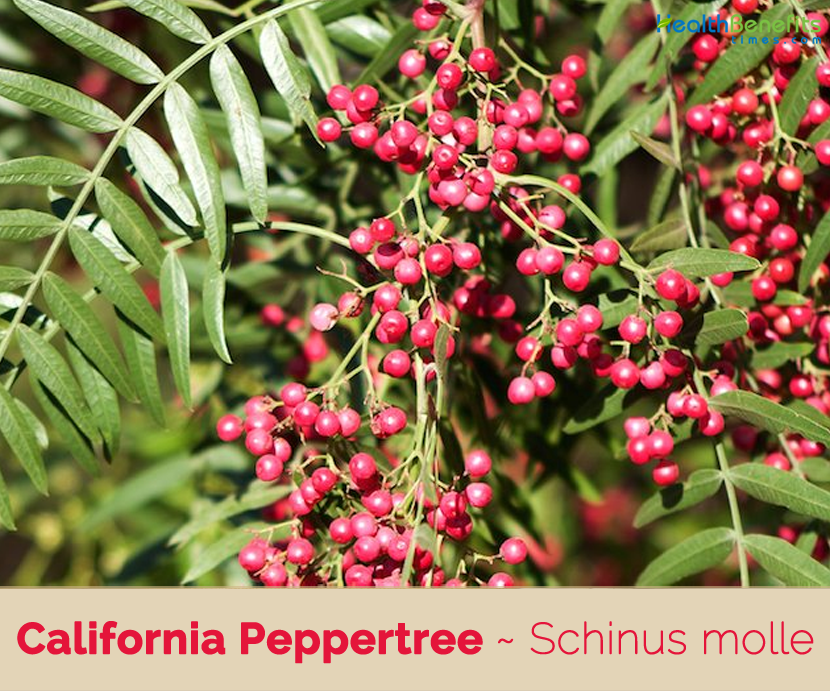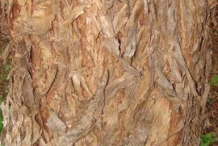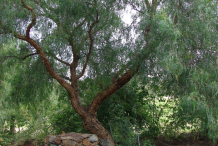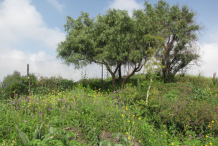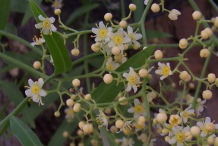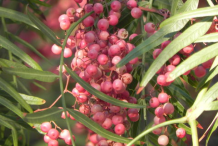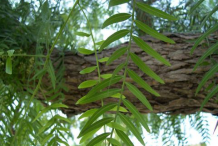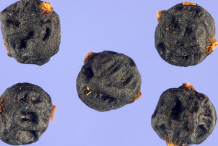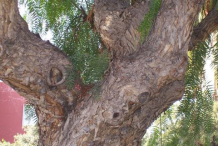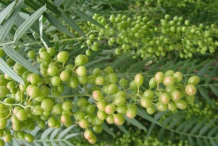The word molle in Schinus molle comes from mulli, the Quechua word for the tree. The similarity of this species to the mastic tree (Pistacia lentiscus) is revealed in the origin of its generic name, from the Greek name for the mastic tree, ‘shinos’. The specific name ‘molle’ is the name by which the tree is known in western South America and is derived from ‘mulli’, the old Peruvian name. The common name ‘pepper-tree’ is due to the fact that the fruits contain seeds with a sharp taste, used for flavoring as a pepper substitute.
Plant Description
California Pepper Tree is a small to medium sized, branched, evergreen, dioecious trees that grows about 15 meters (50 feet) tall and 5–10 meters (16–33 feet) wide, with slender pendant (drooping) branches forming a spreading crown. The plant is found growing in abandoned fields, dry forests, along the banks of waterways and rivers, and slopes. Sandy and well-drained soils are preferable but it is tolerant of waterlogged, poorly drained and infertile soils. It is also tolerant of alkalinity and salinity. Barks are initially smooth gray-brown, later becoming irregularly furrowed with reddish brown splits and grayish coarsely scaly ridges. Twigs are slender, yellow-green and drooping.
Leaves
California Pepper Tree leaves are alternate, imparipinnate on a winged rachis, with 9–20 pairs of opposite or alternate, sessile leaflets which are narrowly lanceolate to linear-lanceolate, 1.5–6 cm long by 0.2–0.8 cm wide, terminal leaflet smaller than lateral ones, grayish green, glabrous to sparsely puberulent with generally entire margins.
Flower & fruit
California Pepper Tree flowers are yellowish white borne profusely in pendant, axillary clusters. Sepals are deltoid, 0.4 mm long; petals are yellowish-white, narrowly ovate, 1.5–2 mm long; styles and stigmas. Flowers are followed by small, globose fruit, 5–8 mm in diameter with woody seeds that turn from green to red, pink or purplish to black. The fruits are carried in dense clusters of hundreds of berries that can be found year-round. Outer part of the fruit is sweet, the inner one bitter. The bark leaves and fruit are all very aromatic when crushed.
Traditional uses and benefits of California Pepper Tree
- In traditional medicine, California Pepper Tree’s parts (leaf, root, fruits, bark, resin) have been used in treating a variety of ailments such as amenorrhea, bronchitis, gingivitis, gonorrhea, gout, tuberculosis, tumor, ulcer, urethritis, wart, wounds, and urogenital and venereal diseases.
- California Pepper Tree also has been used for wounds and infections due to its antibacterial and antiseptic properties.
- California Pepper Tree has also been used as an antidepressant, a diuretic, and for toothache, rheumatism and menstrual disorders.
- California Pepper Tree leaf juice has been used to treat ophthalmic and rheumatism.
- California Pepper Tree bark extract infusion has been used for diarrhea.
- Resin from the bark known as ‘American Mastic’ or ‘Molle resin’ is a potent purgative and has been used to treat digestive disorders.
- Other known medicinal uses of the plant include as an astringent, a balsamic, diuretic, expectorant, masticatory, stomachic, tonic and vulnerary.
- Resinous gum obtained from the bark has been used in folk medicine to treat digestive disorders.
- An essential oil distilled from the fruit is used as a spice in baked goods and candy.
Culinary Uses of California Pepper Tree
- Fruit is savored by children in Ethiopia who consumed the fruit during normal times.
- Dried and roasted California Pepper Tree’s berries are used as a pepper spice substitute.
- Fruits are pulverized and used in cooling drinks called ‘horchatas’ which is relished in South America.
- The natives of the Andes also make a light alcoholic drink, the “chichi de molle” from the fruits.
- Fruit is ground and mixed with other substances to make beverages in Mexico.
- It is used as ingredient for the famous “pulque” to produce intoxicating liquor known as ‘copalocle’ or ‘copalote’ in Mexico.
- Fruits are boiled and used to prepare vinegar or syrup or mixed with maize to make a nourishing light porridge.
- Seeds are sometimes used to adulterate pepper.
- Edible oil distilled from the fruit is used as a spice in baked products and candy.
- Gum that exudes from the bark is used for chewing.
Other Facts
- Schinus molle is often cultivated as an ornamental plant or as shade tree in subtropical and temperate regions.
- Wide, multi-branched crown provides good shade and acts as a suitable windbreak.
- Tree is also planted for soil conservation, as a live fence, barrier or support.
- molle also has been grown as indoor bonsai plants.
- Tree provides a durable termite resistant wood that is used for posts and for both charcoal and firewood.
- Aromatic resin is used as mastic and tannin from the bark is used for tanning skins.
- Latex is produced from many parts of the tree.
- Cortex and leaves also yield a yellow dye.
- Ripe berries and leaves are often cut and used fresh or dried in floral displays.
- Ethanolic and hexanic extracts from fruits and leaves of Schinus molle showed ability to control several insect pests and could have potential use as natural alternatives to synthetic insecticides.
- Oil from the leaves reduces the surface tension of water.
Other Products from California Peppertree
- Food: While not considered poisonous, the berries are not normally eaten. In Mexico, the fruit is ground and mixed with other substances to form beverages. The seeds are sometimes used to adulterate pepper.
- Apiculture: Schinus molleis suitable for bee forage.
- Fuel: Wood of Schinus molle can be burned as both firewood and charcoal.
- Timber: Heartwood is a dull, light red, deepening upon exposure and becoming more or less purplish and rather oily looking; distinct but not sharply demarcated from the brownish-grey sapwood; moderately hard and heavy, specific gravity (air-dry) 0.54-0.68; texture medium to fine, uniform; grain variable, often irregular; very easy to work; durability high; wood is termite resistant and therefore suitable for posts.
- Gum or resin: The tree produces an aromatic resin used as mastic.
- Latex or rubber: Latex is produced from many parts of the tree.
- Tannin or dyestuff: Bark is used for tanning skins.
- Essential oil: Fruit contains a volatile oil and has a flavor resembling that of a mixture of fennel and pepper. The oil of Schinus molle exhibits important activity against several bacterial species, such as Alcaligenes faecalis, Klebsiella pneumoniae and Pseudomonas aeruginosa. The oil also shows the maximum toxic activity against fungus during the screening of some essential oils against some common storage and animal pathogenic fungi.
- Alcohol: An intoxicating liquor known as ‘copalocle’ or ‘copalote’ is obtained by fermenting the fruit with pulque for 1-2 days.
- Poison: The hanging strings of little pink berries of this attractive ornamental tree are reputed to be moderately poisonous, particularly the seed. Leaves are an insect repellant. The pollen, on contact or when inhaled, can cause dermatitis and asthmatic reactions. The tree also has antimicrobial, antifungal, piscicidal and viricidal properties.
- Medicine: Leaf juice is used to treat ophthalmic and rheumatism; a bark extract infusion is used for diarrhea, and resin of the bark is a dangerous purgative. Other known medicinal properties of the tree include using it as an astringent, a balsamic, diuretic, expectorant, masticatory, stomachic, tonic and vulnerary. The ailments it is known to treat include amenorrhea, bronchitis, gingivitis, gonorrhea, gout, tuberculosis, tumor, ulcer, urethritis, wart, wounds, and urogenital and venereal diseases.
Precautions
- Fruit and leaves are, however, potentially poisonous to poultry, pigs and possibly calves.
- Young children may experience vomiting and diarrhea after eating the fruit.
- Seed contains an allergenic substance that can irritate the mucus membrane.
- Avoid use if suffering from Low blood Pressure.
- Do not use during pregnancy and breast feeding.
- In large quantities, they can be toxic.
- Leaves can cause contact dermatitis.
- Gum-resin found in the bark can give rise to contact dermatitis. Pollen, either on contact or when inhaled, can cause dermatitis and asthmatic reactions.
References:
https://www.itis.gov/servlet/SingleRpt/SingleRpt?search_topic=TSN&search_value=28811#null
https://davesgarden.com/guides/pf/go/38316/
http://www.hear.org/pier/species/schinus_molle.htm
https://npgsweb.ars-grin.gov/gringlobal/taxonomydetail.aspx?id=70668
https://www.pfaf.org/user/Plant.aspx?LatinName=schinus+molle
https://www.cabi.org/isc/datasheet/49028
https://plants.usda.gov/core/profile?symbol=SCMO
http://www.theplantlist.org/tpl/record/kew-2480199
https://en.wikipedia.org/wiki/Schinus_molle
http://dendro.cnre.vt.edu/dendrology/syllabus/factsheet.cfm?ID=571
http://www.public.asu.edu/~camartin/plants/Plant%20html%20files/schinusmolle.html
Comments
| California Peppertree Quick Facts | |
|---|---|
| Name: | California Peppertree |
| Scientific Name: | Schinus molle |
| Origin | Subtropical regions of South America – Argentina, Bolivia, Brazil, Chile, Columbia, Ecuador, Peru and Uruguay |
| Colors | Green turning to red, pink or purplish to black |
| Shapes | Small, globose bdrupes, 5–8 mm in diameter |
| Health benefits | Beneficial for amenorrhea, bronchitis, gingivitis, gonorrhea, gout, tuberculosis, tumor, ulcer, urethritis, wart, wounds, and urogenital and venereal diseases |
| Name | California Peppertree |
|---|---|
| Scientific Name | Schinus molle |
| Native | Subtropical regions of South America – Argentina, Bolivia, Brazil, Chile, Columbia, Ecuador, Peru and Uruguay |
| Common Names | American Pepper, Australian Pepper, Brazil Pepper-Tree, Brazilian Peppertree,California Peppertree, Chilean Pepper Tree, Escobilla, False Pepper, Mastic Tree, Molle, Molle Del Peru, Pepper Berry Tree, Pepper Rose, Pepper Tree, Pepperina, Peppertree, Peruvian Mastic Tree, Peruvian Pepper, Peruvian Pepper- Tree, Peruvian Peppertree, Pink Pepper, Pink Peppercorns, Weeping Pepper |
| Name in Other Languages | Afrikaans: Peperboom Amharic: Qundo Berbere Arabic: Felfel-Kazib, Filfilrafie Argentina: Aguaribay, Aguaraiba, Pimienta De America, Pimientillo Escobilla, Chichita, Gualeguay, Falso Pimentero, Molle, Molle Del Perú, Molle Del Incienso Catalan: Pebre Del Perú Chinese: Jia Zhou Hu Jiao (加州胡椒 ) Columbia: Muelle Danish: Peruansk Pebertrae, Peruviansk Pebertrae Dutch: Braziliaanse Peperboom, Californische Peperboom, Mastixbaum, Peruanischer Pfefferbaum, Peruaanse Peperboom, Peperstruik Eastonian: Pehme Skiinus English: American pepper, California peppertree, Peruvian peppertree, Peruvian-mastictree, False pepper, Molle del Peru, Pepper tree, Peppertree, Brazil pepper-tree, Brazilian peppertree, Pink peppercorns, Pepper rose, Jesuit’s Balsam, mastic tree, Estonian: Pehme skiinus Ethiopia: Qundo Berbere Finnish: Brasilianpippuripuu French: Faux Poivrier, Molée Des Jardins, Poivrier d’Amérique, Poivre Rosé German: Brasilianischer Pfeffer, Peruanischer Pfeffer, Peruanischer Pfefferbaum, Rosa Pfeffer, Rosé-Pfeffer Guatamala: Pirú Hebrew: Pilpelon Damui-Aley Hungarian: Perui Bors Italian: Falso Pepe Peruviano, albero del pepe; pepe del Peru; schino Kenya: Mugaita Lithuanian: Švelnusis Pirulis Mexico: Pirú Netherlands: peperboom, Amerikaanse Peru: Cullash, Huinan, Mulli, Molle; Portuguese: Anacauíta, Araguaraíba, Aroeira, Aroeira-Do-Amazonas, Aroeira Folha De Salso, Aroeira-Mansa, Aroeira-Mole, Aroeira-Periquita, Aroeira-Salso, Aroeira-Vermelha, Corneiba Dos Tupis, Pimenteira-Do-Peru, Fruto-De-Sabiá, Pimenteira Bastarda, Pimenteiro, Terebinto, corneiva Quechua: Mulli Russian: Perets Peruanskii (Перец перуанский), Peruanskii Perets (Перуанский перец), Shinus Miagkii ( Шинус мягкий) Somalia: mirimiri South Africa: Umpelempele Spanish: Aguaribai, Aguaraiba, Aguaribay, Anacahuita, Escobilla, Falso pimentero, Molle, Molle del Perú, Molle del Incienso, Pimienta de America, Pimientillo, Pimentero, Pimientero falso, Pirul, lentisco del Perú Swahili: Mpilipili Swedish: Peruanskt Pepparträd, Rosépeppar Tigrina: Berbere-Tselim, Berebere-Tselim Turkish: Yalancı Karabiber Ağacı Uruguay: Aguaribay, Anacahuita, Molle Del Perú, Pimentero, Pirul Zulu: Umpelempele |
| Plant Growth Habit | Small to medium sized, branched, evergreen, dioecious trees |
| Growing Climates | Occurs in abandoned fields, dry forests, along the banks of waterways and rivers, and slopes |
| Soil | Sandy and well-drained soils are preferable but it is tolerant of waterlogged, poorly drained and infertile soils. It is also tolerant of alkalinity and salinity |
| Plant Size | 15 meters (50 feet) tall and 5–10 meters (16–33 feet) wide |
| Bark | Initially smooth gray-brown, later becoming irregularly furrowed with reddish brown splits and grayish coarsely scaly ridges |
| Twigs | Slender, yellow-green, drooping |
| Leaf | Alternate, imparipinnate on a winged rachis, with 9–20 pairs of opposite or alternate, sessile leaflets which are narrowly lanceolate to linear-lanceolate, 1.5–6 cm long by 0.2–0.8 cm wide |
| Flowering Periods | Apr to June |
| Buds | Small and pointed; leaf scars are broadly v-shaped |
| Flower | Yellowish white borne profusely in pendant, axillary clusters. Sepals deltoid, 0.4 mm long; petals yellowish-white, narrowly ovate, 1.5–2 mm long; styles and stigmas |
| Fruit Shape & Size | Small, globose bdrupes, 5–8 mm in diameter |
| Fruit Color | Green turning to red, pink or purplish to black |
| Plant Parts Used | Fruits, bark, leaves |


